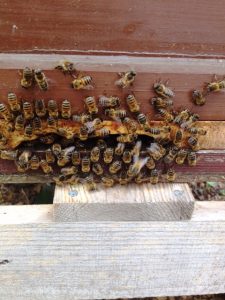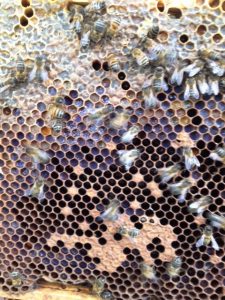The Apiary in August
August is that oh-so-important month as you prepare the Bees for the long winter, when there will be no nectar or pollen available.
But first take off the summer crop of Honey and get it put into jars for sale or buckets for storage. Always a fun time especially if you are extracting in the house kitchen or utility room. The sticky stuff gets everywhere so don’t forget to put newspaper or cardboard on the floor as it will help the final clean- up, although you may still get banned to the shed for next year’s extraction!
Keep a couple of good jars to one side for the looming Honey Show at Tiddington!
When you have extracted the Honey from the supers I never store them ‘wet.’ I put them back on the hive one evening, above an empty super and crown board with the holes clear. The colony will come up and clear down all the residue of Honey and pollen and take it down to the Brood chamber ready for use in the winter.
If you go up one cool evening all the bees will be down in the Brood chamber so put in your Porter bees escapes to clear them down.
Storage of supers is important to keep out wasps, robber bees and mice. If stored in a shed on a spare floor or flat square piece of wood I always put a spare Queen Excluder, then a crown board on top to keep pests away. If stored outside they will need a decent roof on to keep the weather away until you need them again in April 2019.

Wasps have become a real nuisance this season so make sure you renew the mixture in your wasp traps each week and kill off any nests you find nearby with that Ant powder. The front door of the hive needs reducing so put in the wooden mouse guards and if the wasps are still pestering, use grass or gauged zinc to reduce the entrance down to about 4 bees wide, a lot less for them to defend.
As this heat continues the Varroa floors most people use these days will ensure they keep the Brood at the correct temperature to thrive.
It is this time of year I use one or two of my strong colonies to draw out foundation – planning ready for next year! All I do is restrict them down to one Brood chamber, leave on the Queen Excluder, then put on another Brood chamber full of new foundation and feed them loads of syrup which will cause them to draw out the middle frames first which I then move to the outside edges and give them more syrup until all foundation is drawn. They either get overwintered like this or I put all the brand new comb and syrup above an empty super or eke with a crown board in between so they take all the stores down ready to use in the winter. But NO syrup spills and a small entrance or the rest of the Apiary will smell that syrup and try to gain entry.
Varroa treatment next. Put your slides back into your floors and see if you have a heavy natural fall of mites. If you have to treat use one of the authorised and recommended treatments. Please check the National Bee Unit website for what is considered a ‘heavy infestation’ that needs treatment and get it started towards the end of the month whilst it is still warm. One of my delights (sad I know) of the year is emptying the Varroa slides onto newspaper after treatment and having a sacrificial burning of the dead and half dead mites. If you have had a break in the breeding pattern through swarming or breeding Nucs, they may not need treatment but always check as the mites can move hive on the back of Robber Bees or just wait on those lovely flowers the bees visit ready to hitch a ride.
*Always follow the instructions on the packet. Never half treat as their breeding cycle means half the parasites will be in your sealed Brood eating away and breeding their next generation. Last but not least record how and when you treat. Specific forms can be found on the BBKA website or the National Bee Unit. www.nationalbeeunit.com.

As the month draws to a close and the nights draw in, it is time to start feeding the bees so they have sufficient stores to get them through the winter. Syrup I always feed late at night and will help them breed a few strong ‘winter bees.’ The Fondant can go on at any time even into next month.
But don’t leave it too late as the colonies have to ripen the syrup to get rid of as much of the water content as they can or it will ferment half way through the winter and is then no good for man nor Bee.
Last but not least – how many colonies, number-wise, do you want to try and bring through the winter as those small Nuc’s with this year’s Queens will not survive if they have insufficient numbers to breed and produce heat in the depth of winter. So check you have a good, breeding young Queen and then Unite with another colony either killing the older Queen or letting Nature take its’course. There are several ways to do this but putting a sheet of newspaper between the two brood-chambers, Queen Excluder removed, works well or liberal amounts of flour sprinkled over both colonies before uniting also does the trick with *ghost* bees flying around trying to find home.
If you try to bring that special Queen through the winter with a small number of workers please put it in a Poly Nuc, if you have one. The good insulation will give them a fighting chance to survive.
I’ve drilled holes in one side of the Poly Nuc feeders so I can feed Fondant throughout the winter months to give them the best chance I can!
Next month – shutting down for the winter after treatment and finishing the syrup feeding.

